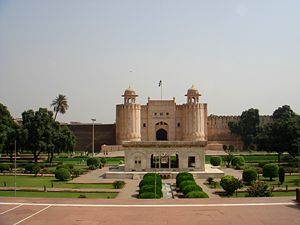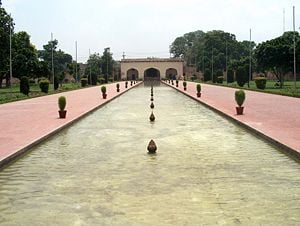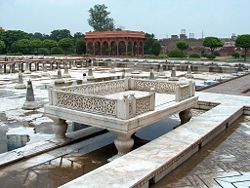Fort and Shalamar Gardens in Lahore
| Lahore Fort* | |
|---|---|
| UNESCO World Heritage Site | |

| |
| State Party | |
| Type | Cultural |
| Criteria | i, ii, iii |
| Reference | 171-172 |
| Region** | Asia-Pacific |
| Inscription history | |
| Inscription | 1981 (5th Session) |
| Endangered | 2000- |
| * Name as inscribed on World Heritage List. ** Region as classified by UNESCO. | |
Lahore Fort
The Lahore Fort, locally referred to as Shahi Qila citadel of the city of Lahore, Punjab, Pakistan. It is located in the northwestern corner of Lahore, adjacent to the Walled City. Some of the famous sites within the fort are: Sheesh Mahal, Alamgiri Gate, Naulakha pavilion, and Moti Masjid. The fort is 1,400 feet long and 1,115 feet wide. In 1981, the fort was inscribed as a UNESCO World Heritage Site along with the Shalamar Gardens.
Origins
The origin of Lahore Fort is obscure. Traditionally the foundation of Lahore and its fort is based on myths and, is attributed to Lav, the son of Rama, the hero of the Ramayana of epic age (1200-800 B.C.E.). However, during the excavation done in the year 1959 C.E. by the Department of Archaeology, in front of Diwan-e-Aam, a gold coin of Mahmood of Ghazni dated A.H. 416 (1025 C.E.) was found at a depth of 25 feet from the level of the lawns. Cultural layers continued to a further depth of 15 feet, giving strong indications that people had lived here, long before the conquest of Lahore by Mahmud in 1021 C.E. Further mention of the fort is traceable to Shahab-ud-din Muhammad Ghuri's successive invasions of Lahore from 1180 to 1186 C.E.
Timeline
- It cannot be said with certainty when the Lahore Fort was originally constructed or by whom, since this information is lost to history, possibly forever. However, evidence found in archaeological digs gives strong indications that it was built long before 1025 C.E.
- 1241 C.E. - Destroyed by Mongols.
- 1267 C.E. - Rebuilt by Sultan Ghiyas ud din Balban.
- 1398 C.E. - Destroyed again, by Amir Tamir's army.
- 1421 C.E. - Rebuilt in mud by Sultan Mubark Shah Syed.
- 1432 C.E. - The fort is occupied by Shaikh Ali of Kabul who makes repairs to the damages inflicted on it by Shaikha Khokhar.
- 1566 C.E. - Rebuilt by Mughal emperor Akbar, in solid brick masonry on its earlier foundations. Also perhaps, its area was extended towards the river Ravi, which then and up to about 1849 C.E., used to flow along its fortification on the north. Akbar also built Doulat Khana-e-Khas-o-Am, the famous Jharoka-e-Darshan (Balcony for Royal Appearance), Masjidi Gate etc.
- 1618 C.E. - Jehangir adds Doulat Khana-e-Jehangir
- 1631 C.E. - Shahjahan builds Shish Mahal (Mirror Palace).
- 1633 C.E. - Shahjahan builds Khawabgah (a dream place or sleeping area), Hamam (bath ) and Khilwat Khana (retiring room).
- 1645 C.E. - Shahjahan builds Diwan-e-Khas (Hall of Special Audience) and probably also Moti Masjid (Pearl Mosque) in the same year.
- 1674 C.E. - Aurangzeb adds the massively fluted Alamgiri Gate.
- (Sometime during) 1799-1839 C.E. - The outer fortification wall on the north with the moat, the marble athdera, Havaeli Mai Jindan and Bara Dari Raja Dhiyan Singh were constructed by Ranjit Singh, Sikh ruler from 1799-1839 C.E.
- 1846 C.E. - Occupied by the British.
- 1927 C.E. - The British hand over the Fort to the Department of Archaeology after demolishing a portion of the fortification wall on the south and converting it into a stepped form thus defortifying the fort.
Shalimar Gardens
| Shalimar Gardens (Lahore), Lahore* | |
|---|---|
| UNESCO World Heritage Site | |

| |
| State Party | |
| Type | Cultural |
| Criteria | i, ii, iii |
| Reference | 171-172 |
| Region** | Asia-Pacific |
| Inscription history | |
| Inscription | 1981 (5th Session) |
| Endangered | 2000- |
| * Name as inscribed on World Heritage List. ** Region as classified by UNESCO. | |
The Shalimar Gardens (Urdu: شالیمار باغ), sometimes written Shalamar Gardens, were built by the Mughal emperor Shah Jahan in Lahore, modern day Pakistan. Construction began in 1641 C.E. (1051 A.H.) and was completed the following year. The project management was carried out under the superintendence of Khalilullah Khan, a noble of Shah Jahan's court, in cooperation with Ali Mardan Khan and Mulla Alaul Maulk Tuni.
General info
The Shalimar Gardens are laid out in the form of an oblong parallelogram, surrounded by a high brick wall, which is famous for its intricate fretwork. The gardens measure 658 meters north to south and 258 meters east to west. In 1981, Shalimar Gardens was included as a UNESCO World Heritage Site along with the Lahore Fort, under the UNESCO Convention concerning the protection of the world's cultural and natural heritage sites in 1972.
The three level terraces of the Gardens
The Gardens have been laid out from south to north in three descending terraces, which are elevated by 4-5 metres (13-15 feet) above one another. The three terraces have names in Urdu as follows:
- The upper terrace named Farah Baksh meaning Bestower of Pleasure.
- The middle terrace named Faiz Baksh meaning Bestower of Goodness.
- The lower terrace named Hayat Baksh meaning Bestower of life.
Shah Nahar : Irrigation of the Gardens
To irrigate the Gardens, a canal named Shah Nahar meaning Royal canal, later also known as Hansti canal, meaning Laughing canal was brought from Rajpot (present day Madhpur in India), a distance of over 161 kilometers. The canal intersected the Gardens and discharged into a large marble basin in the middle terrace.
410 fountains
From this basin, and from the canal, rise 410 fountains, which discharge into wide marble pools. The surrounding area is rendered cooler by the flowing of the fountains, which is a particular relief for visitors during Lahore's blistering summers, with temperature sometimes exceeding 120 degrees fahrenheit. It is a credit to the ingenuity of the Mughal engineers that even today scientists are unable to fathom how the fountains were operated originally. The distribution of the fountains is as follows:
- The upper level terrace has 105 fountains.
- The middle level terrace has 152 fountains.
- The lower level terrace has 153 fountains.
- All combined, the Gardens therefore have 410 fountains.
Water cascades
The Gardens have 5 water cascades including the great marble cascade and Sawan Bhadoon.
Buildings of the Gardens
The buildings of the Gardens include:
|
|
Trees of the Gardens
Some of the varieties of trees that were planted included:
|
|
| |
Site history
The site of the Shalimar Gardens originally belonged to one of the noble Zaildar family in the region, well known as Mian Family Baghbanpura. The family was also given the Royal title of 'Mian' by the Mughal Emperor, for its services to the Empire. Mian Muhammad Yusuf, then the head of Mian family, donated the site of Ishaq Pura to Emperor Shah Jahan, after pressure was placed on the family by the royal engineers, who wished to build on the site due to its good position and soil. In return, Shah Jahan granted the Mian family governance of the Shalimar Gardens. The Shalimar Gardens remained under the custodianship of this family for more than 350 years.
In 1962, the Shalimar Gardens were nationalised by General Ayub Khan because top Mian family members had opposed his imposition of martial law on Pakistan.
The Mela Chiraghan festival used to take place in the Gardens, until President Ayub Khan ordered against it in 1958.
Location of the Gardens
The Shalimar Gardens are located near Baghbanpura along the Grand Trunk Road some 5 kilometers northeast of the main Lahore city.
Fort Lahore Gallery
- Alamgiri Gate2.jpg
Alamgiri Gate - Main Entrance
- Diwan-i-Aam Renovated.jpg
Diwan-e-Aam: Hall of Public Audience (arched vault and ceiling not original)
See also
- Alamgiri Gate
- Hazuri Bagh
- Moti Masjid
- Naulakha pavilion
- Roshnai Gate
- Sheesh Mahal
- Badshahi Mosque
- Wazir Khan Mosque
- Mughal Empire
- List of forts
- Baghbanpura
- Mian Family
- Shalimar Gardens (Kashmir)
- Other World Heritage Sites in Pakistan
- World Heritage Sites
External links
- Lahore Fort as seen from space (Google Maps)
- Pictures - Lahore Fort / Shahi Qila Lahore
- Panographic Images of Lahore Fort And Shalimar Garden at UN's World Heritage Site
- Photos from Lahore Fort by Waqas Usman
- Photographs of Lahore Fort
- Detailed Lahore Fort History/Different Portion (urdu)
- server786.com, Lahore larges photo Gallery
- UNESCO World Heritage Centre
- Photos and information about the Lahore Fort
- Detailed History of Shahi Qila
- Satellite view from Google Maps
- UNESCO World Heritage Centre
- Shalimar Gardens - Photograph
- Photos from Shalamar Gardens by Waqas Usman
- Website of Mian Family Baghbanpura
- Pakistan Paedia
| |||||||
| Emperors: | Babur - Humayun - Akbar - Jahangir - Shah Jahan - Aurangzeb - Lesser Mughals |
| Events: | First battle of Panipat - Second battle of Panipat - Third battle of Panipat |
| Architecture: | Humayun's Tomb - Agra Fort - Badshahi Mosque - Lahore Fort - Red Fort - Taj Mahal - Shalimar Gardens - Pearl Mosque - Bibi Ka Maqbara - See also |
| Adversaries: | Ibrahim Lodhi - Sher Shah Suri - Hemu - Shivaji - Guru Gobind Singh |
Credits
New World Encyclopedia writers and editors rewrote and completed the Wikipedia article in accordance with New World Encyclopedia standards. This article abides by terms of the Creative Commons CC-by-sa 3.0 License (CC-by-sa), which may be used and disseminated with proper attribution. Credit is due under the terms of this license that can reference both the New World Encyclopedia contributors and the selfless volunteer contributors of the Wikimedia Foundation. To cite this article click here for a list of acceptable citing formats.The history of earlier contributions by wikipedians is accessible to researchers here:
The history of this article since it was imported to New World Encyclopedia:
Note: Some restrictions may apply to use of individual images which are separately licensed.












